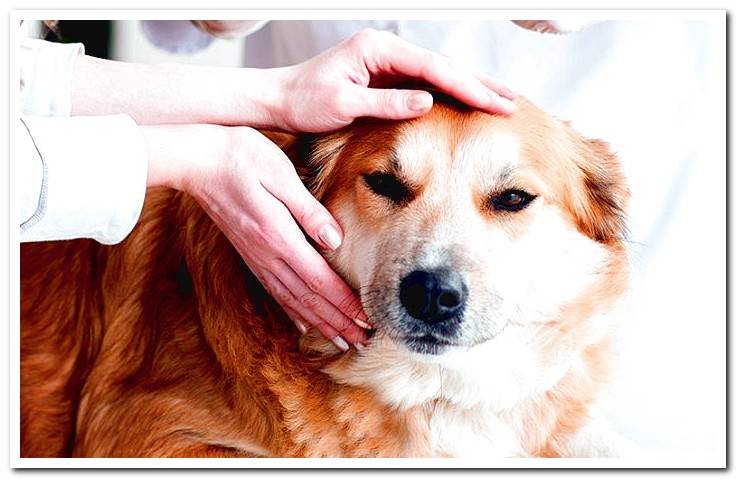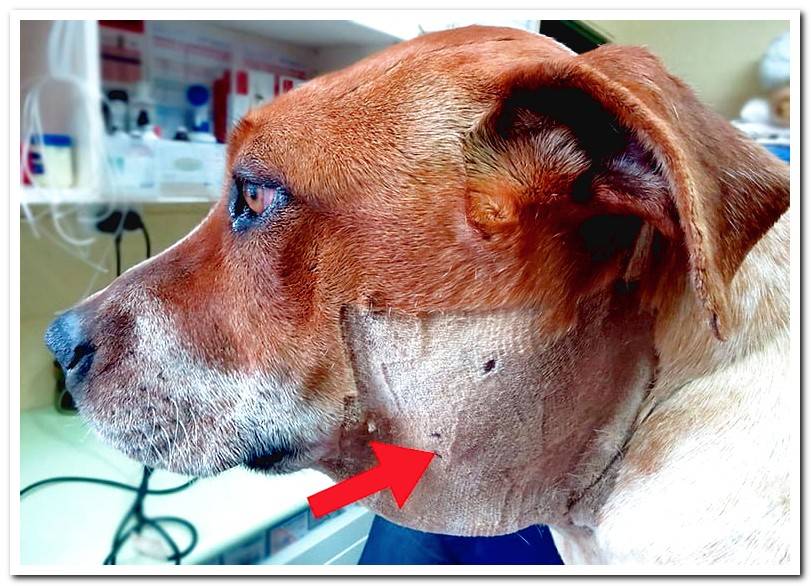
Detecting a ball on our dog’s neck is always a cause for concern. It is easy to associate a lump with cancer, hence the fear many caregivers feel in these cases is understandable.
If we suspect cancer, it is very important to go to the vet as soon as possible. But the truth is that not all lumps are tumors. In this article we are going to explain the most common causes that explain the appearance of a ball in the neck area of dogs.
Index of contents
- 1 Are the balls on a dog’s neck serious?
- 2 Lymph nodes in dogs
- 3 What are abscesses in dogs?
- 4 Tumors in dogs
- 5 Injection site reactions
- 6 Other causes of lumps in the neck
Are the balls on a dog’s neck serious?
To determine it, first of all it is important to look at aspects such as location, size, consistency, the growth rate of the lump or whether or not it is painful to the touch. They are fundamental data when arriving at a diagnosis.
We must also take into account the presence or absence of other symptoms, such as fever, loss of appetite, apathy, etc. If the lump does not disappear, we detect other abnormal signs, it loses some type of secretion or increases in size, we must go to the vet.
There are several causes that can explain the appearance of a ball on the neck of a dog and it is the vet who has to carry out the corresponding examination to determine its origin. Once we obtain a diagnosis, this professional will be able to provide us with the appropriate treatment. The most common causes of lumps in the neck are:
- Increased size of lymph nodes.
- Abscesses
- Tumors
- Reactions after administration of injections.

Lymph nodes in dogs
Lymph nodes are located on both sides of the dogs neck, under the lower jaw. These nodes are part of the immune system and contribute to the defense of the body against the entry of pathogens. A swollen node tells us that the immune system is reacting.
If there is only one swollen node we can think of an infection locally. The node that is closest to the pathogen entry point will be the one that becomes inflamed. So, before a ball in the neck, the first thing we must do is check the mouth for infection.
If this is the case, we will detect other symptoms such as hypersalivation, reluctance to eat, pain, etc. But the infection could also be in the airways. Other signs will appear, such as a runny nose, eye discharge, fever or cough. It is reason for veterinary consultation to choose the treatment.
What are abscesses in dogs?
Abscesses are accumulations of pus under the skin. They are usually due to bites or scratches. The lesion seems to be cured externally, but the truth is that it has been falsely closed and there is an infection underneath. It is not unusual for a dog to have an abscess on the neck, as it is an area where they usually suffer bites from fighting.
Other relatively frequent causes of abscesses are foreign bodies. Vegetable fragments like spines or splinters can get into meat, stay lodged inside the body and, consequently, form an abscess. Insect bites can also form them.
The abscess can open, eliminating secretions to the outside. Sometimes it is enough for the abscess to go away. Other times it does not drain on its own or, although it loses secretions, the lump does not go away. In these cases the vet will remove the pus, thoroughly clean the area and, if necessary, complete the drug treatment.
Tumors in dogs
Tumors are another cause of mass formation in different parts of the body. They are due to uncontrolled growth of cells and are more common in older dogs. For this reason, it is recommended that, at approximately seven years of age, they undergo an annual veterinary review.
This allows some tumors to be detected early. They can be benign or malignant and move to other organs, in a process called metastasis. If we detect a lump and suspect that it may be a tumor, we must immediately go to the vet. Although it is small, it does not hurt or there are no other symptoms.
If it’s cancer, an early diagnosis always offers greater possibilities of cure. The vet will either remove the lump or take a sample to send to the laboratory. This confirms that it is a cancer, of what type and to what degree. This information is basic to start treatment.
Injection site reactions
Sometimes after giving an injection how a vaccine, a reaction may occur just at the point of inoculation. Subcutaneous injections are usually placed in the area of the cross, but if we click higher, we could find a lump in the neck.
Is an inflammation that normally subsides spontaneously in a few days. If it does not or if it worsens, as it could become infected, you must go to the vet for treatment.
Other causes of lumps in the neck
A lump can also correspond to a cyst. In these cases the recommendation is not to touch. If we do, we can cause an infection. They usually disappear spontaneously.
But we need confirmation from the vet, so it is also advisable to go to the consultation as soon as possible. Also, in some dogs we may feel a small lump on the left side. If it is hard and similar to a grain of rice, it will be the microchip.
